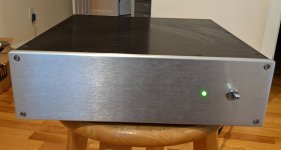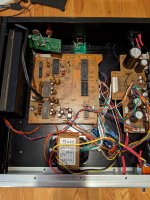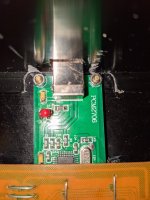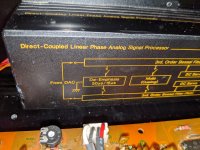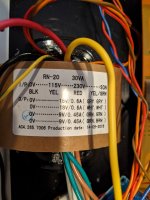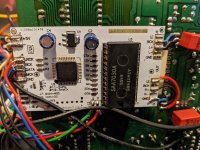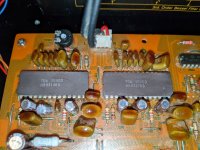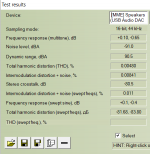Thanks JosephK
I have to read about the close relation about bit depth and sampling rate. I have nothing against running them at upsample frequencies and understand more or less how it can avoid resonances going back in the audible range.
What I do not understand is how it can increase the bith depth capability of the dac chip as half said in the Philips datasheet and fully accepted as an evidence.
I find the phrase a smoke as oversampling is not bits increase on a substract. I accept there is though something I do not understand and Mark has beginned an explain. Rfbw asks me to accept the datasheet as an evidence...but I do not see any explain. Thorsten like Pedja never said these dac chips could increase there bits depth.
As I m sure technically from the golded Philips proto than the 1540 is a 13+1 bit depth substract...while I do not know what is involved here by such means.
Just a curious guy.
I have to read about the close relation about bit depth and sampling rate. I have nothing against running them at upsample frequencies and understand more or less how it can avoid resonances going back in the audible range.
What I do not understand is how it can increase the bith depth capability of the dac chip as half said in the Philips datasheet and fully accepted as an evidence.
I find the phrase a smoke as oversampling is not bits increase on a substract. I accept there is though something I do not understand and Mark has beginned an explain. Rfbw asks me to accept the datasheet as an evidence...but I do not see any explain. Thorsten like Pedja never said these dac chips could increase there bits depth.
As I m sure technically from the golded Philips proto than the 1540 is a 13+1 bit depth substract...while I do not know what is involved here by such means.
Just a curious guy.
Thorsten had explicitly explained on more occasions how the PCM bit depth is increased by oversampling & noise shaping..
Just saying, like correcting historically..
And so Your perception is not correct here, so it would be time to refresh.. 🙂
Just saying, like correcting historically..
And so Your perception is not correct here, so it would be time to refresh.. 🙂
There are two books, "Understanding Delta-Sigma Data Converters," editions 1 and 2. The first edition is written more in plain language that helps give an intuitive understanding of how the processing works. The 2nd edition contains updated information is also a somewhat more formal and mathematical presentation. Each edition has its own merits, so both are worth looking around for to find a used copy. Famous dac books, probably no books better to get started with.
Last edited:
The issue here is that the two books referenced and the datasheets all assume a certain amount of prior knowledge and it can take some considerable effort to acquire said knowledge.
There is a German small manufacturer who modifies Philips players with TDA1540 DACs. He offers a USB interface. I have not listened to it, but can say that my modified (by myself) Philips CD-204 is sounding impressive. I'd prefer a I2S connection, preferably TOSlink, instead of USB. No idea if his adapter is adaptable to that or he could do it. The guy is in the internet (and also on ebay) as "nanocamp".
Good luck!
Good luck!
You have to bring something to the party.
I think you miss a key point. The datasheet is a tool. It is meant for those skilled in the use of that tool. It is not a training guide or teaching tool. In order to make use of it, it is assumed to you are already have the necessary knowledge. To be brutally honest, it is not meant for you.
Rfbw asks me to accept the datasheet as an evidence...but I do not see any explain.
I think you miss a key point. The datasheet is a tool. It is meant for those skilled in the use of that tool. It is not a training guide or teaching tool. In order to make use of it, it is assumed to you are already have the necessary knowledge. To be brutally honest, it is not meant for you.
Ah guys...thank you to have explained it more. I have to read more and the links given.
Your patience is precious...thanks for that 🙂
Your patience is precious...thanks for that 🙂
I think this is the math in the attachment I posted in #25. The example uses 1111 0000 0000 0001 as 16-bit input. Using the algorithm described in the document, the SAA7030 generates 4 14-bit numbers from the 16-bit number and feed them to the TDA1540 at 176.4k
11 1100 0000 0000
11 1100 0000 0000
11 1100 0000 0000
11 1100 0000 0001
The first (most significant) 12-bit of these 14-bit numbers are always the same and it is just shifting 2 bits. The rest of the problem is to represent a 4-bit number using 4 2-bit number.
Since the sum of these 4 14-bit numbers equals to the original 16-bit number, if we add them in the analog domain, we'll get the analog equivalent of the original 16-bit number. This is how it gets 16-bit resolution using a 14-bit dac.
11 1100 0000 0000
11 1100 0000 0000
11 1100 0000 0000
11 1100 0000 0001
The first (most significant) 12-bit of these 14-bit numbers are always the same and it is just shifting 2 bits. The rest of the problem is to represent a 4-bit number using 4 2-bit number.
Since the sum of these 4 14-bit numbers equals to the original 16-bit number, if we add them in the analog domain, we'll get the analog equivalent of the original 16-bit number. This is how it gets 16-bit resolution using a 14-bit dac.
Many many thank to have took the time to explain this. Save a lot of time and will focus my reads more easily 🙂
Unfortunately, you can't just add the value of four consecutive 14-bit, 176.4K samples and expect the result to equal one 16-bit, 44.1K sample. The output of the 16-bit sample is constant over the 44.1K sample period whereas the four 14-bit samples are not. That effects the output when viewed in the time domain. What's more, unless you scrupulously balance the number and position of one bits in the 14-bit samples you will introduce a phase shift in the output.
Agreed and I shouldn't say add, it is more like averaging and there is a low pass filter involved too which cutoff at about 22khz. And when I said the first 12 bits of those numbers are the same. It should be the first 13 bits.
Responding to the OP, I opened up my DAC and took some pictures. I got the Power Supply, DAC Board and Analog section from an old Nakamichi OMS-7. I could have used the original transformer, but I found it runs the 7812, 7805 linear regulators at the voltage limit and too hot, so I am using a 18Vx2 + 9Vx2 transformer. The key is to remove the SAA7030 from the digital board and I mounted the cdream5 translator board on the back side right under where the SAA7030 used to be so I can run the high speed wires shorter. The translator board has just a few wires to connect to the SAA7030. I remember the one thing that took me a while to figure out was the damn Mute line (from the cd player digital section) which in my case has to be connected to 5V otherwise the output relay is left open and no output. I did the RMAA measurement a couple months ago using a Scarlett 2i4 and it was the first time I did any measurements not sure if I did it right.
Responding to the OP, I opened up my DAC and took some pictures. I got the Power Supply, DAC Board and Analog section from an old Nakamichi OMS-7. I could have used the original transformer, but I found it runs the 7812, 7805 linear regulators at the voltage limit and too hot, so I am using a 18Vx2 + 9Vx2 transformer. The key is to remove the SAA7030 from the digital board and I mounted the cdream5 translator board on the back side right under where the SAA7030 used to be so I can run the high speed wires shorter. The translator board has just a few wires to connect to the SAA7030. I remember the one thing that took me a while to figure out was the damn Mute line (from the cd player digital section) which in my case has to be connected to 5V otherwise the output relay is left open and no output. I did the RMAA measurement a couple months ago using a Scarlett 2i4 and it was the first time I did any measurements not sure if I did it right.
Attachments
Hello blackwindstorm. Really interested in your OMS-7 project. Thanks for sharing!
I have an old OMS-5 that's become very unreliable reading CDs and I'd like to try and convert it to a DAC too. Ideally I'd keep it in the original case and use this expanded version of the board that you used for the conversion which should allow direct SPDIF input:

I was planning to power it directly from the main board of the CD player (original power supply). You mentioned that the current might be a little high but would it still work?
Also could you provide any more info on the muting circuit and what I need to do to provide it the correct voltage to keep the output relay open?
I've built another TDA1540 DAC before from a similar kit from the same manufacturer but I'm no electronics expert, very much an amateur!
If you or anyone else could provide any extra guidance it would be much appreciated!
I have an old OMS-5 that's become very unreliable reading CDs and I'd like to try and convert it to a DAC too. Ideally I'd keep it in the original case and use this expanded version of the board that you used for the conversion which should allow direct SPDIF input:
I was planning to power it directly from the main board of the CD player (original power supply). You mentioned that the current might be a little high but would it still work?
Also could you provide any more info on the muting circuit and what I need to do to provide it the correct voltage to keep the output relay open?
I've built another TDA1540 DAC before from a similar kit from the same manufacturer but I'm no electronics expert, very much an amateur!
If you or anyone else could provide any extra guidance it would be much appreciated!
There is a German small manufacturer who modifies Philips players with TDA1540 DACs. He offers a USB interface. I have not listened to it, but can say that my modified (by myself) Philips CD-204 is sounding impressive. I'd prefer a I2S connection, preferably TOSlink, instead of USB. No idea if his adapter is adaptable to that or he could do it. The guy is in the internet (and also on ebay) as "nanocamp".
Good luck!
https://nanocamp-de.translate.goog/?streaming&_x_tr_sl=de&_x_tr_tl=en&_x_tr_hl=el&_x_tr_pto=sc
Thank you eschenborn 🙂
George
I bought this pcb from ebay for my TDA1540 DAC build...................
( https://www.ebay.co.uk/itm/32523126...Wev8eMMzokt0hP0LIOnEt581c=|tkp:Bk9SR4Srg_fXYA )
Very friendly seller.
You can get i2s from SPDIF or USB Sources and feed to this PCB and then this PCB feeds TDA1540's.
P.
( https://www.ebay.co.uk/itm/32523126...Wev8eMMzokt0hP0LIOnEt581c=|tkp:Bk9SR4Srg_fXYA )
Very friendly seller.
You can get i2s from SPDIF or USB Sources and feed to this PCB and then this PCB feeds TDA1540's.
P.
HiI think this is the math in the attachment I posted in #25. The example uses 1111 0000 0000 0001 as 16-bit input. Using the algorithm described in the document, the SAA7030 generates 4 14-bit numbers from the 16-bit number and feed them to the TDA1540 at 176.4k
11 1100 0000 0000
11 1100 0000 0000
11 1100 0000 0000
11 1100 0000 0001
The first (most significant) 12-bit of these 14-bit numbers are always the same and it is just shifting 2 bits. The rest of the problem is to represent a 4-bit number using 4 2-bit number.
Since the sum of these 4 14-bit numbers equals to the original 16-bit number, if we add them in the analog domain, we'll get the analog equivalent of the original 16-bit number. This is how it gets 16-bit resolution using a 14-bit dac.
but how to apply same rule for the example of F11F.
thanks
/
example F11F = 1111 0001 0001 1111
- 00 = 1111 0001 0001 1111
- 01 = 1111 0001 0010 0000
- 10 = 1111 0001 0010 0001
- 11 = 1111 0001 0010 0010
first 14 bits: changed some bits before 12bit
1111 0001 0001 11
1111 0001 0010 00
1111 0001 0010 00
1111 0001 0010 00
sum: correct
1111 0001 0001 1111
Beautiful thread.
IMO This thread in its own way demonstrates once more time that beauty (or ugliness) is in the eyes of the beholder.
What someone "seems" actually impossible does not mean that it "is" impossible.
And it also shows that the beauty of this forum surely top leading worldwide is in the extraordinary people that populates it.
Sometimes I spend a few hours to read it by having a lot of fun on topics that I technically understand yes and no at 5%.
I'm certainly not qualified to be able to say it, but: really a so very exceptional forum!
I also thought about the fact that even the replies that seem (and probably are) the "worst" because apparently defeatist have their usefulness: they make the thread rise in the top reading positions and then the character who resolved exactly what you asked and suddenly arrives and which seemed impossible just before to someone's eyes it is not only become possible, but even real 😀 (for the OP's joy).
How great.
Thanks to all of you!
Please forgive my useless intrusion and my English: just sayin'...
IMO This thread in its own way demonstrates once more time that beauty (or ugliness) is in the eyes of the beholder.
What someone "seems" actually impossible does not mean that it "is" impossible.
And it also shows that the beauty of this forum surely top leading worldwide is in the extraordinary people that populates it.
Sometimes I spend a few hours to read it by having a lot of fun on topics that I technically understand yes and no at 5%.
I'm certainly not qualified to be able to say it, but: really a so very exceptional forum!
I also thought about the fact that even the replies that seem (and probably are) the "worst" because apparently defeatist have their usefulness: they make the thread rise in the top reading positions and then the character who resolved exactly what you asked and suddenly arrives and which seemed impossible just before to someone's eyes it is not only become possible, but even real 😀 (for the OP's joy).
How great.
Thanks to all of you!
Please forgive my useless intrusion and my English: just sayin'...
Spend too much time in this forum and one might start to think that human intelligence is on the retreat.
Instead, it seems that you assume that I assume...You assume it is aimed at you but if the cap fits....
Most of all because it is not really understood to who your sentence was addressed.
And please note you still didn't answer my previous question.
Is this what happens to you?Spend too much time in this forum and one might start to think that human intelligence is on the retreat.
Even so, you know, in the beautiful place where I live some people make a game of dexterity with the playing cards (which is actually at the limits of the scam) which is called "The 3-card Game".
It consists showing it to the only player (who is actually "the victim") the 3 cards with which we play: 2 cards are equal and 1 card is different.
With great speed and ability, the game "master" pretends to put the cards in a certain way, but then to the very last moment suddenly changes its direction.
The player (the "victim") does not notice the change of final direction because the game "master" as said is skilled and very fast.
He is so good that the player (that's "the victim") always loses, I mean: always.
Few words to the wise
- Home
- Source & Line
- Digital Line Level
- Old TDA1540 as a "modern DAC"
